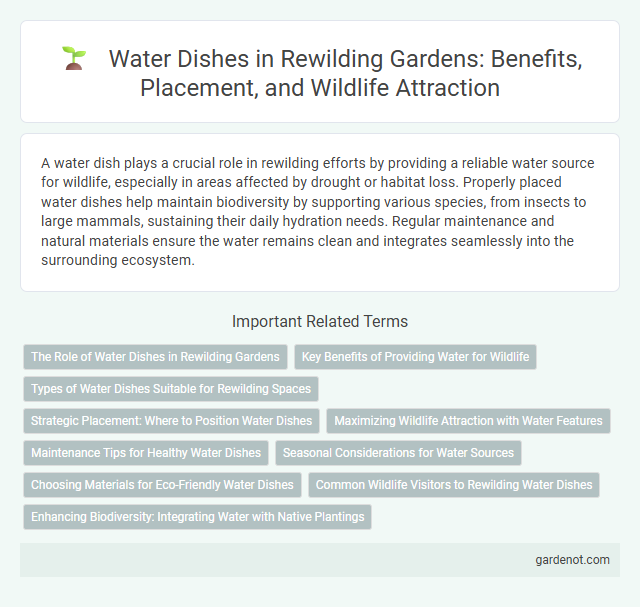A water dish plays a crucial role in rewilding efforts by providing a reliable water source for wildlife, especially in areas affected by drought or habitat loss. Properly placed water dishes help maintain biodiversity by supporting various species, from insects to large mammals, sustaining their daily hydration needs. Regular maintenance and natural materials ensure the water remains clean and integrates seamlessly into the surrounding ecosystem.
The Role of Water Dishes in Rewilding Gardens
Water dishes play a critical role in rewilding gardens by providing essential hydration sources for local wildlife such as birds, insects, and small mammals. These water features help create microhabitats that support biodiversity and encourage natural behaviors like foraging and nesting. Properly maintained water dishes enhance ecosystem balance by facilitating species survival and promoting ecological interactions within rewilded spaces.
Key Benefits of Providing Water for Wildlife
Providing water dishes for wildlife supports hydration, essential for survival and reproductive success in various species. These water sources promote biodiversity by attracting a wide range of animals, including birds, mammals, and insects, enhancing ecosystem balance. Regular access to clean water helps maintain health and resilience in native wildlife populations, especially during dry seasons or drought conditions.
Types of Water Dishes Suitable for Rewilding Spaces
Water dishes suitable for rewilding spaces include naturalistic options such as shallow stone basins, birdbaths with textured surfaces, and large ceramic bowls that mimic natural water sources. Materials like untreated wood, stone, and unglazed ceramics ensure non-toxicity and durability, promoting wildlife hydration without contamination. Incorporating water dishes with varying depths supports diverse species, from small insects to larger mammals, enhancing ecosystem hydration and biodiversity.
Strategic Placement: Where to Position Water Dishes
Position water dishes near natural animal trails or shaded areas to maximize accessibility and encourage wildlife visitation. Placing dishes close to native vegetation helps integrate them seamlessly into the habitat, reducing stress for animals and promoting natural behavior. Ensuring water sources are distributed evenly across the rewilding site prevents territorial disputes and supports broad ecosystem balance.
Maximizing Wildlife Attraction with Water Features
Water dishes designed with shallow edges and natural materials significantly enhance wildlife attraction by providing safe drinking and bathing spots for a variety of species. Incorporating features like varying water depths and surrounding vegetation creates microhabitats that support amphibians, birds, and mammals while promoting biodiversity. Regularly cleaned, strategically placed water dishes near native plantings optimize hydration access and encourage sustained wildlife presence in rewilding projects.
Maintenance Tips for Healthy Water Dishes
Regular cleaning of water dishes prevents algae buildup and bacterial growth, ensuring safe hydration for wildlife. Use non-toxic brushes and avoid harsh chemicals to preserve natural water quality. Frequent refilling with fresh water maintains optimal hygiene and attracts diverse animal species for successful rewilding efforts.
Seasonal Considerations for Water Sources
Seasonal variations critically impact water availability in rewilding projects, with dry seasons often causing natural water bodies to shrink or disappear. Implementing water dishes or artificial water sources can sustain wildlife populations during drought periods, ensuring consistent hydration. Strategic placement near habitats promotes animal health and supports biodiversity by compensating for natural fluctuations in water resources.
Choosing Materials for Eco-Friendly Water Dishes
Selecting eco-friendly materials for water dishes is crucial in rewilding projects to minimize environmental impact and support wildlife health. Biodegradable options like bamboo, terracotta, and recycled plastics ensure durability while reducing pollution and chemical leaching. Natural stone or untreated wood also provide sustainable, non-toxic choices that blend seamlessly into restored ecosystems.
Common Wildlife Visitors to Rewilding Water Dishes
Rewilding water dishes attract a variety of common wildlife visitors including birds such as robins, finches, and thrushes, which rely on clean water sources for drinking and bathing. Small mammals like hedgehogs and squirrels also frequent these water dishes, especially in dry seasons when natural water is scarce. Amphibians such as frogs and newts benefit from the presence of water dishes, which supplement their hydration and support local biodiversity.
Enhancing Biodiversity: Integrating Water with Native Plantings
Incorporating water dishes within native plantings creates critical hydration points that support diverse wildlife, including pollinators, amphibians, and birds. These water features promote ecosystem balance by sustaining native species and encouraging natural behaviors essential for reproduction and foraging. Such integration fosters resilient habitats, increasing overall biodiversity and ecological connectivity in rewilding projects.
Water dish Infographic

 gardenot.com
gardenot.com